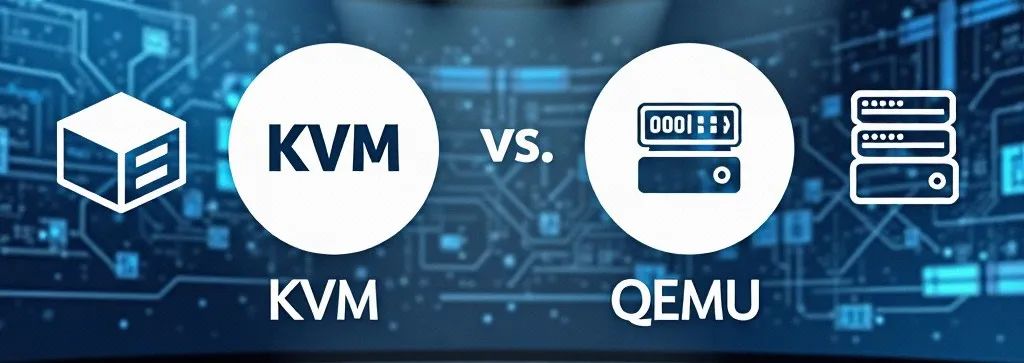In the field of Linux virtualization, KVM and QEMU are the two most common tools. Many people have heard of them, but often confuse their differences, with some even mistakenly believing they are the same thing. Today, we will unveil their mysteries and explore the characteristics, roles, and how KVM and QEMU work together!
1. What is QEMU?
QEMU (Quick Emulator) is an open-source general-purpose hardware emulator and virtual machine manager that can simulate hardware such as CPU, memory, and hard drives across different architectures, running various operating systems.
Core Features of QEMU:
✅ Cross-platform support: Can run on different architectures such as x86, ARM, PowerPC. ✅ Pure software emulation: Can simulate CPUs and peripherals, running systems of different architectures (e.g., running ARM systems on x86). ✅ Standalone operation: QEMU can run as a complete virtual machine manager (similar to VirtualBox) or work with KVM for more efficient virtualization.
Use Cases for QEMU:
-
Running virtual machines between different architectures (e.g., running ARM systems on x86).
-
Used for embedded development, testing applications on different CPU architectures.
-
As a debugging tool, analyzing software behavior in a virtual environment.
Disadvantages:
-
In pure software emulation mode, performance is lower, and the running speed is much slower than real hardware.
2. What is KVM?
KVM (Kernel-based Virtual Machine) is a virtualization module in the Linux kernel that allows Linux to function as an efficient virtual machine manager (Hypervisor).
Core Features of KVM:
✅ Hardware acceleration: KVM relies on CPU virtualization extensions (Intel VT-x / AMD-V) to provide near bare-metal performance. ✅ Lightweight: KVM is essentially part of the Linux kernel, with no additional performance overhead. ✅ Robust ecosystem: KVM can be used with tools like QEMU, Libvirt, and OpenStack to build enterprise-level cloud computing platforms.
Use Cases for KVM:
-
Cloud computing environments (e.g., OpenStack, Proxmox).
-
Enterprise server virtualization (e.g., KVM + Libvirt solutions).
-
High-performance virtual machines (running Linux, Windows, etc.).
Disadvantages:
-
Can only run on CPUs that support Intel VT-x / AMD-V.
-
Depends on the Linux kernel and cannot run independently.
3. Differences and Collaboration between KVM and QEMU
| Comparison Item | QEMU | KVM |
|---|---|---|
| Type | Full software emulator & virtual machine manager | Kernel-level virtualization module |
| Performance | Pure software emulation, lower performance | Relies on CPU hardware acceleration, near bare-metal performance |
| Requires VT-x/AMD-V | No | Yes |
| Can run independently | Yes | No, depends on the Linux kernel |
| Use Cases | Cross-architecture emulation (e.g., x86 running ARM) | High-performance virtual machines (e.g., cloud computing) |
| Eco-system | Mainly used for emulation and testing | Used in conjunction with Libvirt, OpenStack |
KVM + QEMU: The Golden Combination!
KVM is just a module in the Linux kernel and does not have complete virtual machine management capabilities, while QEMU provides full virtual machine management. Therefore, they are often used together:
✅ QEMU acts as the front end, managing hardware emulation and I/O operations of virtual machines. ✅ KVM acts as the back end, providing CPU hardware acceleration to enhance virtual machine performance.
In this mode, QEMU is responsible for I/O device emulation, while KVM handles CPU and memory management, allowing virtual machines to run at speeds close to real hardware.
4. How to Use KVM + QEMU?
4.1 Installing KVM and QEMU
On Ubuntu/Debian systems:
sudo apt update && sudo apt install -y qemu-kvm libvirt-daemon-system libvirt-clients bridge-utils virt-managerOn CentOS/RHEL systems:
sudo yum install -y qemu-kvm libvirt virt-install bridge-utils4.2 Creating a KVM Virtual Machine
-
Check if KVM is available:
kvm-ok # If the output is "KVM acceleration can be used", it means KVM can be used-
Create a virtual machine using
<strong><span>virt-manager</span></strong>(GUI operation).
virt-manager-
Create a virtual machine via command line:
virt-install --name ubuntu-vm \--ram 2048 --vcpus 2 --disk size=20 \--cdrom /path/to/ubuntu.iso --os-type linux --os-variant ubuntu20.044.3 Starting and Managing KVM Virtual Machines
virsh list --all # View all virtual machines
virsh start ubuntu-vm # Start the virtual machine
virsh shutdown ubuntu-vm # Shut down the virtual machine5. Summary
-
QEMU is a general-purpose hardware emulator that can run on different architectures, but its pure software emulation performance is low.
-
KVM is a Linux kernel module that provides hardware-accelerated virtualization, with performance close to bare metal.
-
The combination of QEMU + KVM allows you to enjoy the flexibility of QEMU while leveraging the high performance of KVM, making it the best solution for Linux server virtualization.
Do you now have a clearer understanding of the differences between KVM and QEMU? If you are using KVM or QEMU, feel free to share your experiences in the comments! 🚀